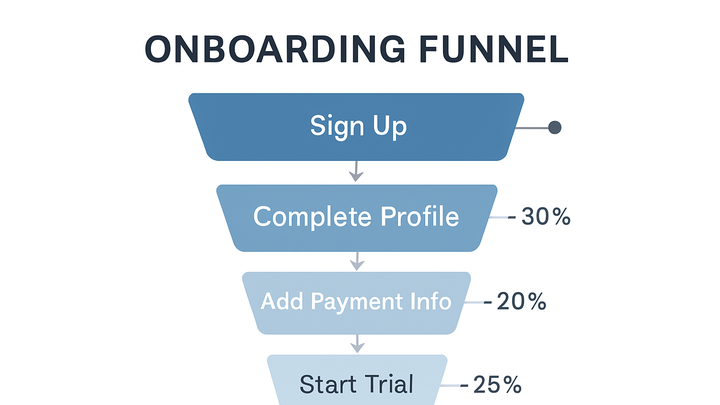Published on 2025-06-22T04:06:25Z
What is an Onboarding Funnel in Analytics? Examples and Implementation
An Onboarding Funnel in analytics refers to a series of defined steps that new users take from their initial visit to achieving a meaningful first action (often called the ‘activation’ moment). Funnel analysis lets product, marketing, and analytics teams measure how effectively they guide new users toward activation, where drop-offs can signal friction or confusion. By instrumenting events for each stage—like landing page views, sign-ups, email confirmations, and first key actions—organizations gain visibility into where users churn. Tools like Google Analytics 4 (GA4) and PlainSignal (a cookie-free, privacy-friendly analytics service) make it easy to capture and visualize these funnel stages. This article covers the key stages of an onboarding funnel, how to implement tracking using GA4 and PlainSignal, and strategies to analyze and optimize your funnel for higher conversions and user retention.
Onboarding funnel
Series of tracked stages guiding users from initial visit to activation, enabling teams to measure and optimize onboarding performance.
Overview and Importance
An onboarding funnel maps the critical steps new users take towards their first success, helping teams understand and improve user activation. By measuring conversion rates and drop-off points, organizations can pinpoint friction in the user journey and focus optimization efforts where they matter most.
-
Ensuring user success
The onboarding funnel outlines sequential steps that guide users toward the ‘aha’ moment, boosting engagement and retention.
-
Measuring progress
Tracking each stage provides quantitative insights into where users abandon the process and where improvements yield the biggest gains.
Key Stages of an Onboarding Funnel
While funnels vary by product, most onboarding processes share common stages that new users navigate.
-
Step 1: landing/entry
User arrives at the marketing landing page, homepage, or promotional link—marking the starting point of the funnel.
-
Step 2: signup/register
User completes a registration form and verifies their account to gain access to product features.
-
Form optimization
Implement inline validation, clear field labels, and progress indicators to reduce abandonment.
-
-
Step 3: activation
User performs an initial key action—such as creating a profile, uploading data, or completing a tutorial—that signifies first value.
Implementing Onboarding Funnel Tracking
Capture each onboarding step as an event in your analytics tool to populate funnel reports and dashboards.
-
Google analytics 4 (GA4)
GA4 provides a Funnel Exploration report where you define events for each stage and visualize conversion paths.
-
GA4 setup code
<script async src='https://www.googletagmanager.com/gtag/js?id=GA_MEASUREMENT_ID'></script> <script> window.dataLayer = window.dataLayer || []; function gtag(){dataLayer.push(arguments);} gtag('js', new Date()); gtag('config', 'GA_MEASUREMENT_ID'); // Example event for sign_up step gtag('event', 'sign_up', { method: 'Email' }); </script>
-
-
PlainSignal (cookie-free analytics)
PlainSignal offers simple, privacy-friendly tracking with minimal setup. Use the following snippet to capture pageviews and send custom events for each funnel stage.
-
PlainSignal tracking snippet
<link rel='preconnect' href='//eu.plainsignal.com/' crossorigin /> <script defer data-do='yourwebsitedomain.com' data-id='0GQV1xmtzQQ' data-api='//eu.plainsignal.com' src='//cdn.plainsignal.com/plainsignal-min.js'></script> -
Custom event tracking
After installation, send custom events for each step using:
ps.track('signup_complete', { plan: 'pro' });
-
Analyzing and Optimizing Your Onboarding Funnel
With tracking in place, leverage funnel reports to identify drop-offs, test improvements, and personalize the onboarding experience for better conversions.
-
Identify drop-off points
Examine conversion rates between stages to locate friction and high-abandon areas that need attention.
-
A/b testing
Experiment with different sign-up flows, form layouts, and CTA copy to determine what drives the highest engagement.
-
Personalization
Segment users by source, persona, or behavior to deliver tailored onboarding flows that resonate with each audience.
